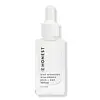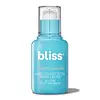What's inside
What's inside
 Key Ingredients
Key Ingredients

 Benefits
Benefits

 Concerns
Concerns

No concerns
 Ingredients Side-by-side
Ingredients Side-by-side

Water
Skin ConditioningArgania Spinosa Kernel Oil
EmollientPropanediol
SolventActinidia Chinensis Seed Oil
EmollientGlycerin
HumectantBetaine
HumectantSerine
MaskingAlanine
MaskingGlycine
BufferingPCA
HumectantThreonine
Arginine
MaskingProline
Skin ConditioningGlutamic Acid
HumectantLysine Hcl
Skin ConditioningSodium Lactate
BufferingSodium PCA
HumectantHydrolyzed Sodium Hyaluronate
Skin ConditioningSodium Acetylated Hyaluronate
HumectantNephelium Lappaceum Peel Extract
Skin ConditioningTocopherol
AntioxidantTrisodium Ethylenediamine Disuccinate
1,2-Hexanediol
Skin ConditioningCaprylyl Glycol
EmollientHydroxyacetophenone
AntioxidantLysolecithin
EmulsifyingSclerotium Gum
Emulsion StabilisingXanthan Gum
EmulsifyingPullulan
Silica
AbrasiveSodium Hydroxide
BufferingWater, Argania Spinosa Kernel Oil, Propanediol, Actinidia Chinensis Seed Oil, Glycerin, Betaine, Serine, Alanine, Glycine, PCA, Threonine, Arginine, Proline, Glutamic Acid, Lysine Hcl, Sodium Lactate, Sodium PCA, Hydrolyzed Sodium Hyaluronate, Sodium Acetylated Hyaluronate, Nephelium Lappaceum Peel Extract, Tocopherol, Trisodium Ethylenediamine Disuccinate, 1,2-Hexanediol, Caprylyl Glycol, Hydroxyacetophenone, Lysolecithin, Sclerotium Gum, Xanthan Gum, Pullulan, Silica, Sodium Hydroxide
Water
Skin ConditioningPropanediol
SolventGlycerin
HumectantSodium Hyaluronate
HumectantSodium Hyaluronate Crosspolymer
HumectantHydrolyzed Sodium Hyaluronate
Skin ConditioningSodium Acetylated Hyaluronate
HumectantPanthenol
Skin ConditioningArginine
MaskingSerine
MaskingAlanine
MaskingGlycine
BufferingThreonine
Proline
Skin ConditioningLysine Hcl
Skin ConditioningGlutamic Acid
HumectantPCA
HumectantSodium PCA
HumectantChamomilla Recutita Flower Extract
MaskingSaccharide Isomerate
HumectantSodium Lactate
BufferingPolyacrylate Crosspolymer-6
Emulsion StabilisingHydroxyethyl Acrylate/Sodium Acryloyldimethyl Taurate Copolymer
Emulsion StabilisingPolyglyceryl-10 Caprylate
EmulsifyingSorbitan Isostearate
EmulsifyingPolysorbate 60
EmulsifyingBetaine
HumectantPentylene Glycol
Skin ConditioningSodium Citrate
BufferingSodium Phytate
Tetrasodium Glutamate Diacetate
Phenoxyethanol
PreservativeEthylhexylglycerin
Skin ConditioningCitric Acid
BufferingSodium Hydroxide
BufferingWater, Propanediol, Glycerin, Sodium Hyaluronate, Sodium Hyaluronate Crosspolymer, Hydrolyzed Sodium Hyaluronate, Sodium Acetylated Hyaluronate, Panthenol, Arginine, Serine, Alanine, Glycine, Threonine, Proline, Lysine Hcl, Glutamic Acid, PCA, Sodium PCA, Chamomilla Recutita Flower Extract, Saccharide Isomerate, Sodium Lactate, Polyacrylate Crosspolymer-6, Hydroxyethyl Acrylate/Sodium Acryloyldimethyl Taurate Copolymer, Polyglyceryl-10 Caprylate, Sorbitan Isostearate, Polysorbate 60, Betaine, Pentylene Glycol, Sodium Citrate, Sodium Phytate, Tetrasodium Glutamate Diacetate, Phenoxyethanol, Ethylhexylglycerin, Citric Acid, Sodium Hydroxide
Ingredients Explained
These ingredients are found in both products.
Ingredients higher up in an ingredient list are typically present in a larger amount.
Alanine is an amino acid and is already found in the human body. Our skin uses alanine to build collagen, elastin, and keratin.
Arginine is an amino acid that is important for human development. Your body uses is it to produce hair keratin and skin collagen.
As a cosmetic ingredient, Arginine has antioxidant properties and can also help repair damaged skin. This ingredient is derived either synthetically or from animals.
Arginine isn't fungal acne safe when used in the presence of other lipids (fats, fatty acids, oils, esters, etc). Oils and fats occur naturally within the skin, so take caution when using Arginine if you're prone to fungal acne.
Learn more about ArginineBetaine is a common humectant (a substance that promotes retention of moisture). It's known to be gentle on the skin and can help balance hydration.
This ingredient is best for improving hydration and soothing irritated skin. Studies also show it helps even out skin tone.
Fun fact: Betaine is naturally created in the skin and body. The kind found within cosmetic products can be either plant-derived or synthetic.
Another name for betaine is trimethylglycine.
Learn more about BetaineGlutamic Acid is an amino acid that is found in all living organisms. Our bodies use this to help nerve cells in the brain communicate with other cells.
In cosmetics, glutamic acid is a famous humectant. It draws water from the air to your skin, keeping your skin hydrated (like hyaluronic acid).
An in-vitro study from 2024 found glutamic acid to play a role in inhibiting inflammation and thus a potential skin-soothing ingredient.
Other studies show it to be have potential wound healing, skin barrier repair, and hair growth properties.
Glutamic acid has poor solubility in water and other solvents.
Learn more about Glutamic AcidGlycerin is already naturally found in your skin. It helps moisturize and protect your skin.
A study from 2016 found glycerin to be more effective as a humectant than AHAs and hyaluronic acid.
As a humectant, it helps the skin stay hydrated by pulling moisture to your skin. The low molecular weight of glycerin allows it to pull moisture into the deeper layers of your skin.
Hydrated skin improves your skin barrier; Your skin barrier helps protect against irritants and bacteria.
Glycerin has also been found to have antimicrobial and antiviral properties. Due to these properties, glycerin is often used in wound and burn treatments.
In cosmetics, glycerin is usually derived from plants such as soybean or palm. However, it can also be sourced from animals, such as tallow or animal fat.
This ingredient is organic, colorless, odorless, and non-toxic.
Glycerin is the name for this ingredient in American English. British English uses Glycerol/Glycerine.
Learn more about GlycerinThis ingredient is an amino acid that helps build proteins and moisturizes skin. It is already present in our skin as our bodies produce them naturally.
Glycine already plays a role in helping keep our skin moisturized as amino acids transport moisture throughout our skin.
As collagen is made up of glycine and other amino acids, it is believed glycine may help our skin produce more collagen.
Learn more about GlycineThis ingredient is created by putting sodium hyaluronate through hydrolysis.
You might know this as 'mini' or 'ultra low-molecular weight' hyaluronic acid. The small molecule size means it is able to travel deeper in the skin.
According to studies, low molecular-weight hyaluronic acid can:
One study from 2011 found ultra-low weight HA to show pro-inflammatory properties. Another study from 2022 found it to downregulate UV-B induced inflammation.
Hydrolysis is a process of changing a molecule using water or enzymes.
This ingredient is water-soluble.
Learn more about Hydrolyzed Sodium HyaluronateLysine HCl is an alpha amino acid salt.
Our skin uses amino acids as a precursor for building protein, and therefore keratins, collagen and elastin.
PCA is derived from amino acids and is naturally found in our skin's barrier.
As a humectant, PCA helps draw and hold moisture to the skin. Studies show it is effective at helping the skin stay hydrated long-term.
Proline is an amino-acid. It helps moisturize the skin and plays an important role in creating proteins.
Our skin uses proline as one of the building blocks for producing collagen.
In medicine, proline is used as an osmoprotectant. This means it helps prevent oxidative degradation in other drugs.
Our bodies are able to produce proline naturally, but certain conditions may inhibit this production. In that case, proline can be obtained from eating egg whites, soy protein, dairy products, asparagus, mushrooms, and seaweed.
Learn more about ProlinePropanediol is an all-star ingredient. It softens, hydrates, and smooths the skin.
It’s often used to:
Propanediol is not likely to cause sensitivity and considered safe to use. It is derived from corn or petroleum with a clear color and no scent.
Learn more about PropanediolSerine is an amino acid naturally found in our body. Our bodies use amino acids to create protein.
Amino-acids help give keep our skin hydrated. They play an important role in the skin barrier, which keeps the skin plump and firm.
Serine is a non-essential amino acid, meaning we don't need to obtain it from eating foods.
Learn more about SerineSodium Acetylated Hyaluronate is a type of Hyaluronic Acid.
Hyaluronic Acids help moisturize, soothe, and protect the skin.
Read about common types of Hyaluronic Acid here:
Sodium Hyaluronate
Hydrolyzed Hyaluronic Acid
Hyaluronic Acid
Sodium Hydroxide is also known as lye or caustic soda. It is used to adjust the pH of products; many ingredients require a specific pH to be effective.
In small amounts, sodium hydroxide is considered safe to use. However, large amounts may cause chemical burns due to its high alkaline.
Your skin has a natural pH and acid mantle. This acid mantle helps prevent harmful bacteria from breaking through. The acid mantle also helps keep your skin hydrated.
"Alkaline" refers to a high pH level. A low pH level would be considered acidic.
Learn more about Sodium HydroxideSodium Lactate is the sodium salt of lactic acid, an AHA. It is a humectant and sometimes used to adjust the pH of a product.
This ingredient is part of our skin's NMF, or natural moisturizing factor. Our NMF is essential for the hydration of our top skin layers and plasticity of skin. NMF also influences our skin's natural acid mantle and pH, which protects our skin from harmful bacteria.
High percentages of Sodium Lactate can have an exfoliating effect.
Fun fact: Sodium Lactate is produced from fermented sugar.
Learn more about Sodium LactateSodium PCA is the sodium salt of pyroglutamic acid. It is naturally occurring in our skin's natural moisturizing factors where it works to maintain hydration.
The PCA stands for pyrrolidone carboxylic acid, a natural amino acid derivative.
This ingredient has skin conditioning, anti-inflammatory, and humectant properties. Humectants help hydrate your skin by drawing moisture from the air. This helps keep your skin moisturized.
Learn more about Sodium PCAThreonine is an amino-acid. It helps hydrate the skin and has antioxidant benefits.
Our skin uses threonine for creating collagen and elastin. Humans are not able to create threonine and must get it through eating foods such as fish, lentils, poultry, sesame seeds, and more.
Water. It's the most common cosmetic ingredient of all. You'll usually see it at the top of ingredient lists, meaning that it makes up the largest part of the product.
So why is it so popular? Water most often acts as a solvent - this means that it helps dissolve other ingredients into the formulation.
You'll also recognize water as that liquid we all need to stay alive. If you see this, drink a glass of water. Stay hydrated!
Learn more about Water